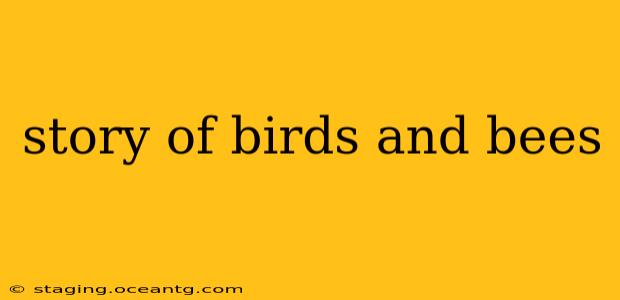The phrase "birds and the bees" is a common euphemism for explaining the complexities of sexual reproduction to children. While the phrase itself is simple, the actual story of how birds and bees, and indeed all living things, reproduce is incredibly diverse and fascinating. This comprehensive guide delves into the reproductive strategies of these two iconic groups, highlighting the surprising similarities and striking differences in their approaches to creating the next generation.
What is the Story of the Birds and the Bees Really About?
At its core, the "birds and bees" story is about sexual reproduction – the process by which organisms create offspring through the combination of genetic material from two parents. This process, while fundamental to life on Earth, is incredibly diverse, with countless variations across the animal kingdom. The story uses birds and bees as representatives of two very different reproductive strategies: one relying on internal fertilization and elaborate courtship rituals (birds), and the other employing a more direct, albeit equally complex, approach involving pollination (bees).
How Do Birds Reproduce?
Birds, belonging to the class Aves, exhibit a fascinating array of reproductive behaviors. Their reproductive strategy centers around internal fertilization, meaning the sperm fertilizes the egg inside the female's body.
Bird Courtship Rituals: A Dance of Attraction
Many bird species have elaborate courtship rituals designed to attract a mate. These can include spectacular displays of plumage, intricate songs, and complex dances. The purpose of these rituals is to demonstrate fitness and genetic quality, increasing the chances of successful mating and offspring survival.
Nest Building and Egg Laying: Creating a Safe Haven
Once a pair bonds, the next step is often nest building. The type of nest varies significantly depending on the species, ranging from simple scrapes on the ground to intricately woven structures in trees. The female then lays eggs, which are incubated (kept warm) until they hatch. Parental care varies widely; some species share incubation and chick-rearing duties, while others leave it primarily to the female or male.
Avian Reproduction: A Diverse Landscape
The diversity of bird reproduction is remarkable. Some species are monogamous, mating with only one partner for a breeding season or even a lifetime. Others are polygynous (one male, multiple females) or polyandrous (one female, multiple males). These variations reflect the evolutionary pressures shaping their reproductive success in different environments.
How Do Bees Reproduce?
Bees, members of the order Hymenoptera, have a reproductive strategy centered around pollination and a complex social structure. While their reproductive process is different from birds, it's equally intricate and vital to the planet's ecosystems.
Pollination: The Foundation of Bee Reproduction
Bees play a crucial role in pollination, the transfer of pollen from the male part of a flower (stamen) to the female part (pistil). As bees collect nectar and pollen for food, they inadvertently transfer pollen between flowers, facilitating fertilization and seed production. This process is essential for the reproduction of many plant species.
Bee Society and Reproduction: A Hierarchy of Roles
In many bee species, particularly honeybees, there's a highly structured social hierarchy. A single queen bee is responsible for laying eggs, while worker bees, all female, perform tasks such as foraging, nest building, and brood care. Male drones exist solely to mate with the queen. The queen's reproductive success is vital to the colony's survival.
Bee Reproduction: A Tale of Two Sexes
The queen bee mates with multiple drones, storing their sperm for later use. She lays fertilized eggs that develop into female workers or queens, and unfertilized eggs that develop into male drones. The sex of the offspring is determined by whether the egg is fertilized.
What are the Similarities and Differences Between Bird and Bee Reproduction?
While seemingly disparate, bird and bee reproduction share some fundamental similarities. Both involve the production of gametes (sperm and eggs), fertilization, and the development of offspring. However, the methods and contexts differ significantly. Birds employ internal fertilization and often exhibit complex courtship behaviors, while bees rely on pollination and exhibit social structures influencing reproduction. The primary difference lies in the mechanism of fertilization – internal for birds and indirect (through pollination) for bees.
Why is Understanding the "Story of the Birds and Bees" Important?
Understanding the reproductive strategies of diverse organisms is crucial for several reasons. It enhances our understanding of biodiversity, the interconnectedness of ecosystems, and the importance of conservation efforts. Furthermore, understanding reproductive biology helps us appreciate the remarkable adaptations that have evolved in different species to ensure their survival and propagation. It also contributes to research in areas like agriculture (pollination) and wildlife management.
This exploration of bird and bee reproduction only scratches the surface of the vast and wondrous world of animal reproduction. The complexities and diversity found in nature continue to inspire awe and wonder, reminding us of the intricate processes that underpin the continuation of life on Earth.
